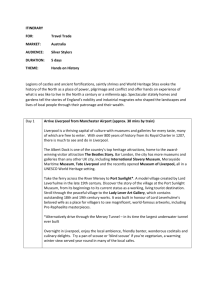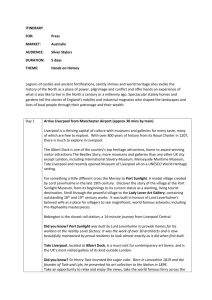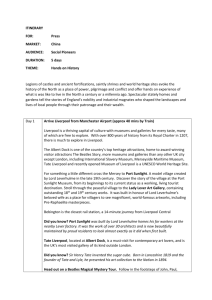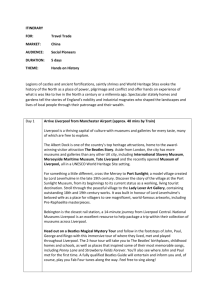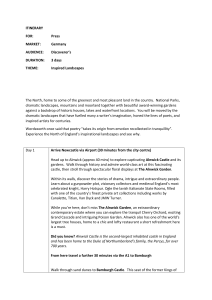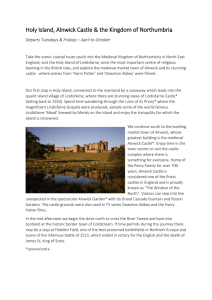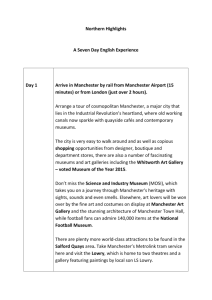Hands on History (Word, 24KB)
advertisement
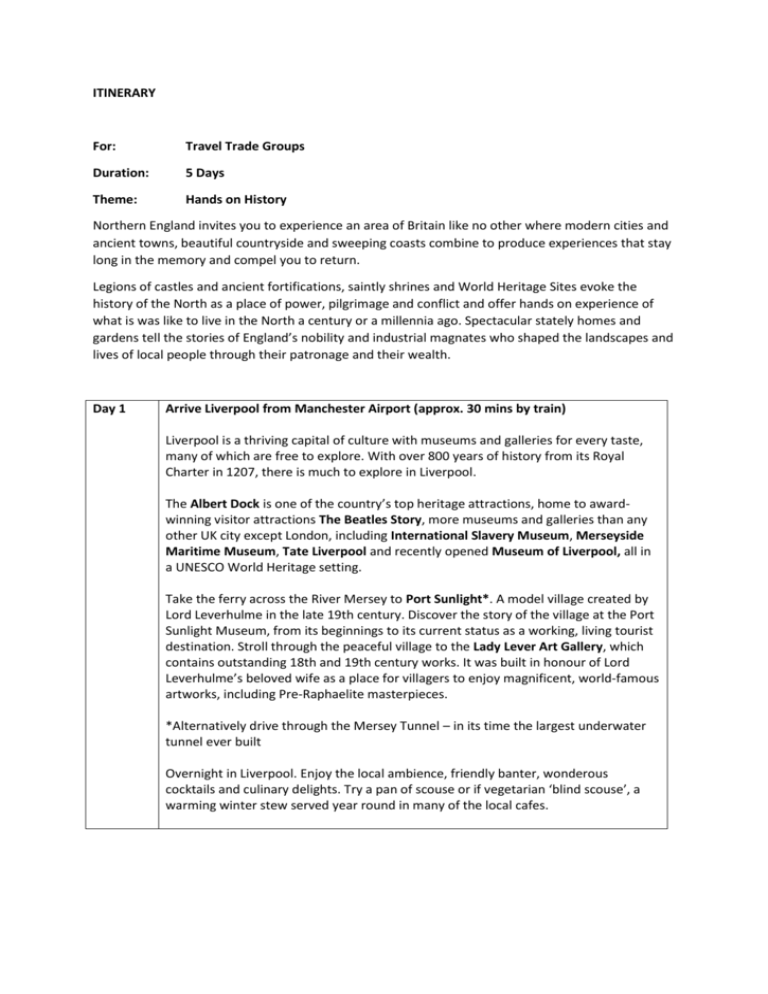
ITINERARY For: Travel Trade Groups Duration: 5 Days Theme: Hands on History Northern England invites you to experience an area of Britain like no other where modern cities and ancient towns, beautiful countryside and sweeping coasts combine to produce experiences that stay long in the memory and compel you to return. Legions of castles and ancient fortifications, saintly shrines and World Heritage Sites evoke the history of the North as a place of power, pilgrimage and conflict and offer hands on experience of what is was like to live in the North a century or a millennia ago. Spectacular stately homes and gardens tell the stories of England’s nobility and industrial magnates who shaped the landscapes and lives of local people through their patronage and their wealth. Day 1 Arrive Liverpool from Manchester Airport (approx. 30 mins by train) Liverpool is a thriving capital of culture with museums and galleries for every taste, many of which are free to explore. With over 800 years of history from its Royal Charter in 1207, there is much to explore in Liverpool. The Albert Dock is one of the country’s top heritage attractions, home to awardwinning visitor attractions The Beatles Story, more museums and galleries than any other UK city except London, including International Slavery Museum, Merseyside Maritime Museum, Tate Liverpool and recently opened Museum of Liverpool, all in a UNESCO World Heritage setting. Take the ferry across the River Mersey to Port Sunlight*. A model village created by Lord Leverhulme in the late 19th century. Discover the story of the village at the Port Sunlight Museum, from its beginnings to its current status as a working, living tourist destination. Stroll through the peaceful village to the Lady Lever Art Gallery, which contains outstanding 18th and 19th century works. It was built in honour of Lord Leverhulme’s beloved wife as a place for villagers to enjoy magnificent, world-famous artworks, including Pre-Raphaelite masterpieces. *Alternatively drive through the Mersey Tunnel – in its time the largest underwater tunnel ever built Overnight in Liverpool. Enjoy the local ambience, friendly banter, wonderous cocktails and culinary delights. Try a pan of scouse or if vegetarian ‘blind scouse’, a warming winter stew served year round in many of the local cafes. Day 2 Travel to Manchester by Train (approx. 45 minutes on the M62) Famous as the birthplace of England’s Industrial Revolution, the city of Manchester has long been connected with science and industry. Its Museum of Science and Industry is on the site of the world’s oldest surviving railway station. Here, visitors can get a unique insight into the region’s unrivalled legacy for scientific innovation. Also, find out how Manchester’s famous inventions helped shape the modern world, from the world’s first steam-powered mill to the splitting of the atom. Gets hands-on with history and experience what it was like to work in a cotton mill at Quarry Bank Mill, a National Trust property 10 miles south of Manchester. Travel on the A56 to Bury to ride a steam train on the East Lancashire Railway. This beautifully restored heritage railway puffs back in time through stunning countryside, quaint villages and historic towns. The East Lancashire Railway* is a 12-mile heritage steam railway line through the Irwell Valley. With its scenic blend of rolling countryside and post-industrial landscapes, the journey offers a taste of what train travel was like in Victorian England. Disembark at Ramsbottom, a village synonymous with its industrial heritage, enjoy a stroll around the shops, the antiques centre, and visit one of the many tea shops or the local pub, with plenty of time to catch the return journey to Bury where you can visit the famous market and perhaps partake in Bury’s famous delicacy, Black Pudding. *Journeys for the Railway depart from Bolton Street station in the town of Bury, 10 miles north of Manchester. Overnight in Manchester. Enjoy a cocktail at Manchester’s Cloud in the Hilton, and fabulous food in the fashionable Spinningfields quarter of Manchester or head up to the Northern Quarter, a uniquely ‘Mancunian’ neighbourhood: alternative, bohemian and creative. Home to countless independent bars, cafés and restaurants, visitors can spend hours browsing through its art galleries, boutiques and vintage stores. Taste classic English dishes at TNQ restaurant and bar before heading to Apotheca to sample its range of quirky and inventive cocktails. Day 3 Travel to Lancashire, a short 40 minutes’ drive along the M6 to go back in time at Lancashire's halls and historic houses before continuing onto Hadrian’s Wall Choose from four historic homes to explore, each fascinating in different ways. Gawthorpe Hall is Lancashire's very own 'Downton Abbey'. The striking Elizabethan house is famed for its architecture and extensive textile collection. Hoghton Tower is 450 years old and still in prime condition as an attraction and hotel – its tower has spectacular views of its landmark driveway, and it is famous for being where King James 1st knighted a cut of beef – 'Sir Loin' – in 1617. Fourteen generations of the same family have lived at 16th century Browsholme Hall, and there’s a good chance of you bumping into family members on a tour of the house. Also a family home, Leighton Hall was owned by a renowned furniture-making family during the 19th century and has stunning views across Morecambe Bay. Group bookings welcome with coach parking and specialist tours available. Continue your journey on to Hadrian’s Wall through the Lake District’s villages (approx 1hr 40 from Preston) Explore Hadrian’s Wall by bike, bus, on foot or with a guided tour from Carlisle. The 80-mile (129-km) corridor that is Hadrian’s Wall represents the most significant monument built by the Romans in Britain. It stretches across the very top of England, and you can explore it in a variety of exciting ways. Take the ‘Emperor Hadrian, Reivers and Edward 1st 'Longshanks' Tour’. Expert guides escort you around the key sites in North Cumbria experiencing Hadrian's Wall, the homes of the great 'Reiver' families and medieval sites such as those associated with Edward 1st‘s last days. Alternatively, there’s a bus – aptly named the AD122 (when the Wall was constructed) – that runs the length of the wall, taking in forts, museums, towns and villages along the way. Head over to Newcastle on the A69 (1hr 20mins) for an overnight stay to enjoy the delights of Newcastle’s waterfront and seven bridges, famous local ales, cuisine and the unbeatable Geordie welcome. Whilst in Newcastle, check the local theatres and the Royal Northern Sinfonia for orchestral performances. Day 4 Travel along the A1 (approx. 45 mins from Newcastle) and explore captivating Alnwick Castle and its gardens. Walk through history and admire world-class art at this fascinating castle, then stroll through spectacular floral displays at The Alnwick Garden. Alnwick Castle, the second-largest inhabited castle in England, has been home to the Duke of Northumberland’s family, the Percys, for over 700 years. Within its walls, discover the stories of drama, intrigue and extraordinary people. Learn about a gunpowder plotter, visionary collectors and medieval England’s most celebrated knight, Harry Hotspur. Ogle the lavish Italianate State Rooms, filled with one of the country’s finest private art collections including works by Canaletto, Titian, Van Dyck and JMW Turner. While you’re here, don’t miss The Alnwick Garden, an extraordinary contemporary estate where you can explore the tranquil Cherry Orchard, exciting Grand Cascade and intriguing Poison Garden. Alnwick also has one of the world’s largest treehouses, home to a chic and lofty restaurant, where afternoon tea is sure to be fun. Once refreshed head up to Bamburgh Castle on the scenic coastal route via the B1340 Bamburgh Castle is one of England’s most iconic landmarks. It dominates a wild stretch of northeast England’s coastline, towering above grass-covered sand dunes. Just as dramatic is the view you will see from inside the castle walls, along the beach and out to the Farne Islands, home to puffins and grey seals. As one of the country’s largest inhabited castles, Bamburgh is living history. This site has been occupied since prehistoric times, witnessing bloody battles, royal rebellion and secret negotiations. The imposing keep was built to survive raids in the 12th century, while the King’s Hall is a Victorian masterpiece made for elaborate banquets and balls. And every summer, Bamburgh reveals more of its past in live archaeological excavations. Travel to York along the A1M approx. 2 hrs 20mins for a final night’s stay in the historic City of York. Day 5 Travel back 2,000 years at revealing York Minster. One of the world’s loveliest Gothic Cathedrals and certainly England’s largest, York Minster dominates the city below it and houses countless treasures in its atmospheric depths. Venture down into its underground chambers to find the new attraction called Revealing York Minster. Here you can explore clever interactive galleries combining ancient craftsmanship, recent excavations and cutting-edge science to tell the site’s 2,000-year history. Follow in the footsteps of Roman soldiers and see their excavated barracks. Discover why York claims to be the birthplace of Christianity in Europe. Admire a Viking lord’s 1,000-year-old carved elephant tusk, and explore ancient illuminated manuscripts. Upstairs, gaze on the world’s largest medieval stained-glass window, often called the English Sistine Chapel, then climb the narrow twisting staircase to the parapet and experience the sensational views. Enjoy a bird's-eye view of the city and stroll along its 13th century defensive city walls, passing historic landmarks, gatehouses and gardens. The ancient fortifications that encircle York’s historic centre are the longest and most complete city walls in England. Walk along their superbly preserved ramparts and it’s easy to imagine yourself as a patrolling Roman guard, medieval archer or a soldier dodging cannonballs during the Civil War. First built in Roman times around 71 AD, then largely replaced by medieval stonework, the walls stretch for over 2 miles (3.4km). It takes about 2 hours to walk the full circuit. One of Europe’s best-preserved medieval shopping streets, with cheerful cafés and quirky shops in timber-framed buildings was once voted ‘Britain’s most picturesque street’. The Shambles is a shopping destination like no other; a curiously quaint, flagstoned avenue overhung haphazardly by timber-framed houses dating from the 15th century. Smell the delicious aromas wafting from chocolatiers, fudge-makers and cafés, and browse unique jewellery, leather goods, woollens, curiosities and antiques in old-fashioned shop fronts. Afternoon tea doesn’t come any more traditional than at Bettys tearooms. Famed for its Grand Cru Chocolate Torte, Yorkshire Fat Rascal scones and elegant afternoon teas, there’s also a choice of 50 different beverages including varieties from Yorkshire Tea, Britain’s favourite tea.
